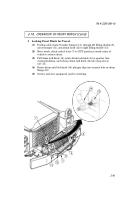TM-9-2320-386-10 - Page 87 of 223
a.
Ensure front winch, tools, and auxiliary equipment are locked and stowed for
travel.
b.
Start engine (paras. 2-12 and 2-13).
c.
Set light switch (2) to desired position (para. 2-24).
NOTE
• When going forward on upgrade terrain, or reverse on downgrade
terrain, do not release parking brake until transmission is engaged.
• During vehicle operation on extreme slopes, the operator may
experience loping or hunting idle and an oil pressure drop to 5-8 psi
(35-55 kPa) when engine speed falls within a 700-900 RPM range.
Though not desirable, these sudden drops in engine performance
are normal and will not cause damage to the engine.
2-15. PLACING THE VEHICLE IN MOTION
TM 9-2320-386-10
2-54
d.
Push parking brake lever (5) down to release parking brake.
e.
Check ECU (1) for correct pressure setting (para. 2-19).
f.
Place transmission gearshift lever (3) in DRIVE or REVERSE positions, as
desired.
g.
Depress accelerator pedal (6) to increase vehicle speed.
CAUTION
• Do not allow engine speed to exceed 2700 rpm as shown on
tachometer in any transmission gearshift lever position.
• Do not downshift transmission gearshift lever more than one posi-
tion at a time.
• When shifting from 2 (second) position to 1 (first) position, or
from NEUTRAL position to REVERSE position, vehicle must be
brought to a complete stop. Failure to do this may result in
damage to transmission.
• When down-shifting, vehicle speed must not exceed speed of next
lower gear as shown on data plate. Doing this may result in
damage to transmission.
1
2
Back to Top




















